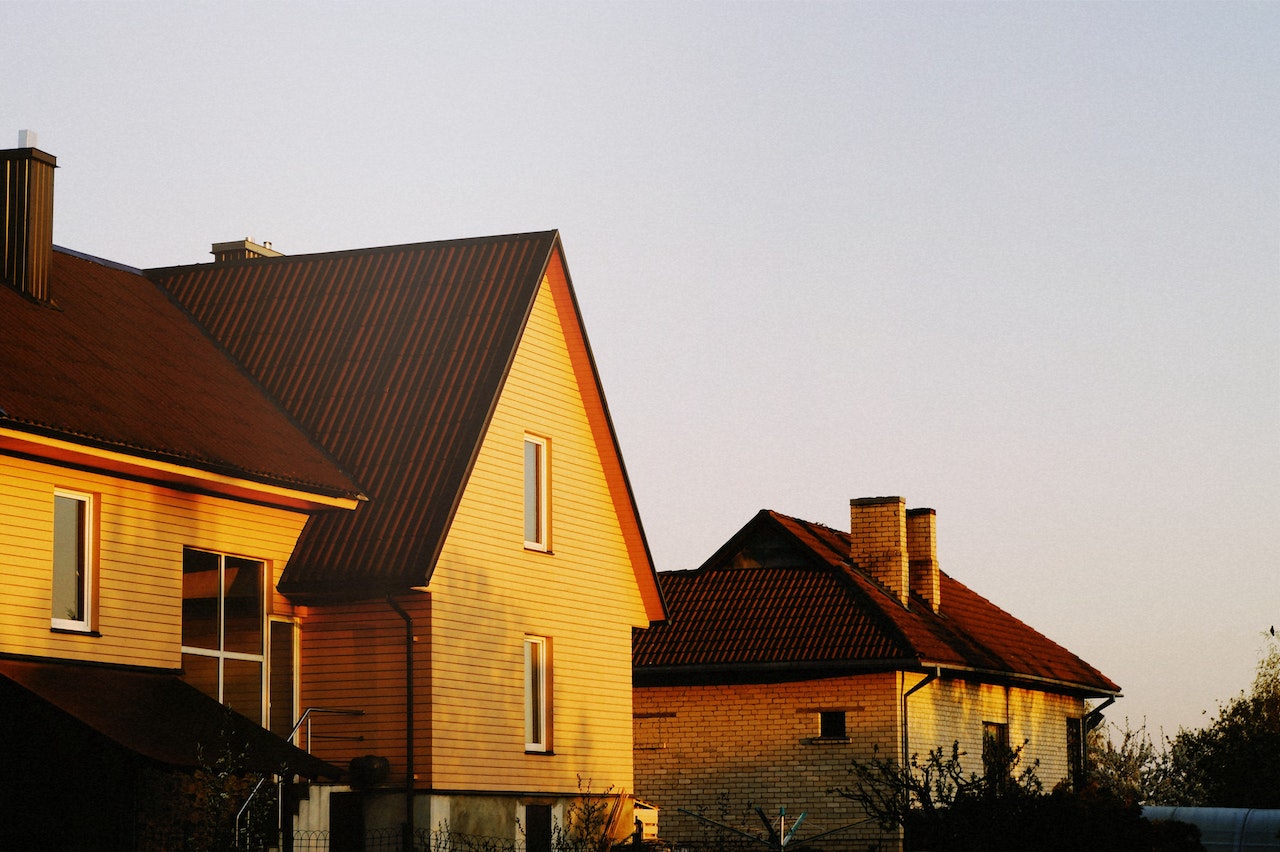Gable End Windows Cost
Gable end windows are the finishing touch to an extension or loft conversion, costing from £900 for a simple square UPVC window fitted into an existing brick wall up to £20,000 or more for bespoke vaulted glazing!
Often found in attic conversions, a gable end window can be a full-size picture window, replacing one aspect of your property with laminated glass. The scale and specification of your gable end windows will be the primary cost factor.
Looking for an accurate cost of a gable end window? Fill out the form below and we'll put you in touch with local window fitters in your area - compare costs for free! Time complete - 30 seconds.
You can find countless options to produce a dramatic impact on a pitched roof extension, from casement windows to custom-engineered structural glass.
Factors That Impact the Average Gable End Window Cost
Gable end windows are typically fitted into an angled frame. The idea is that the glass runs parallel with the pitch of your roof in an arched triangular shape to maximise lighting and views.
You can, of course, fit regular window frames into a conversion, which a contractor can build into the gable end walls. The cost will be much lower - involving cutting through the brickwork, installing a lintel and the supply and labour costs.
Get quotes for new windows
See how we work below.
Gable End Window Frame Materials
With significant variables, the cost of gable end windows spans a wide scope - a huge structural conversion could be £80,000 or above, but simple triangular windows cost on average:
- £500 to £1,250 for UPVC frames.
- £625 to £1,600 for an aluminium unit.
- £750 to £1,900 for timber windows.
Note that those averages are based on supply costs for standard window sizes with triangular glazing - you'd need to incorporate the price of cutting through the wall and fitting a lintel if you're installing an apex window in an existing wall.
The gable sits directly under the roofline, and you have numerous design possibilities, from installing sliding doors with a balcony, solid glass walls, partitioned glass or fixed panels.
Most gable ends are installed on the top floor, with floor-to-ceiling glass to make the most of the space - but you could also make the entire frontage a statement glass wall, which will inevitably be a pricier project.
Complex gable end windows spanning multiple floors require steel supports and fixings with high-specification toughened glass.
The most important budgetary consideration is whether you'd like full gable end windows, partial or offset glazing.
Additional Considerations in Fitting Gable End Windows
Another contributing cost factor is the type of window you choose. Gable end windows are diverse in design so that you can combine them with roof lights, glass railings, sliding or bifold doors, and different glazing types.
Triangular Apex Windows
The standard is a triangular gable end window, which suits any property with a pitched roof. Many homeowners install the triangular window above a bifold set of doors, which looks like a glass wall and works incredibly well on ground-floor extensions.
There are many ways to structure the angles of the window to match your property - you can also commission a window fitter to build a right-angled frame that evens out an unbalanced roof pitch.
Triangle Gable End Windows With Upstands
An upstand is a vertical panel that runs through the glass or partitions two smaller panes of glazing. This option works nicely if you have a high ceiling, and you can match the bars to a bifold door underneath for a uniform appearance.
Trapezoid Gable End Glazing
If your gable end has a flat roof rather than an arch, a trapezoid is a good fit, aligning the window with the aperture while getting the same benefits in natural light.
As an alternative to a standard casement window, the unusual shape adds character and value, with adjustable angles so the frame slots in perfectly.
You can also fit the upstands we mentioned to the trapezoid apex windows incorporating a drop to add flexibility and different sides to the glazing, which means you can expand the glazing further.
Gable End Glazing Types
Your next factor is the type of glass you'd like in your gable end windows.
This decision may be guided by the design and scale of your apex glazing - very large picture windows or structural glass walls will require safety glass as a building regulation requirement.
Some of the most popular options include:
- Obscure glazing, retaining privacy while allowing as much sunlight to enter your home as possible. Opaque glass can restrict visibility into your property while allowing you a full view of the scenery outside.
- Noise and heat-reducing glass: acoustic glass can make a huge difference if you live close to busy roads or airports. Laminated inner panels include a sound insulation foil that prevents excess noise from reaching your home. This property can also reduce rain noise, avoid overheating in the summer and is easy to keep clean.
- Energy-efficient glazing: heating costs are soaring, so choosing new gable end windows with as high a specification as possible makes sense. Energy-efficiency glass is heat strengthened to avoid heat loss in the window, remain cool in the summer, and prevent condensation from forming on the windows.
- Triple-glazing is the most effective glass available, although more expensive than double-glazing. The benefits are noise reduction, thermal protection and high security.
Laminated safety glazing, as we've discussed, will be required for any large windows or glass within a certain proximity of floors or external entrances.
That's because glass that isn't elevated away from the floor poses a potential safety risk, so it needs to be tough enough to withstand knocks and impacts.
Reinforced glass has an outer panel that is toughened to the highest post, which means that even if the window were to break due to extreme pressure, it would hold together without smashing into splinters.
Benefits of Choosing Gable End Windows for Your Home
There are many benefits to choosing a striking gable end window, finishing off a new loft conversion, replacing standard frames in an upper floor room, or creating a unique finish for an extension project.
Modern triangular apex windows bring several advantages to your property:
- Increased natural light - the window runs along your roofline, allowing in substantially more sunlight than a standard rectangular window frame.
- Enhanced views - the lack of framing makes the most of the outdoors, and if your gable end is fitted in an attic space, it can deliver panoramic views of the surrounding area.
- Flush fit - angled frames utilise all of the wall space available, with greater design freedom than a standard window. Larger glazing makes a room feel more airy and spacious.
- Statement aesthetics - there's little doubt that an angled frame looks unusual and means a property stands out from the crowd. Most homes with apex windows maximising the quality of a loft conversion appreciate in value.
- Bespoke design choices - although you can select an off-the-shelf window to bring light to a loft or upper floor, a custom gable end window means you can pick and choose from different angles, sizes, colours and grid designs.
- Energy efficiency - modern gable end windows are constructed to advanced standards, with thermal protection, weatherproofing and quality frames, normally with a warranty of 20 years or more.
- Security - a new window fitted to British standards delivers excellent protection for your property.
Checkout this fascinating time lapse video of a gable window installation:
Frequently Asked Questions - Gable End Window Cost
Here we've answered the most frequently asked questions about fitting a gable end window and the options you have to make your mark on your property.
Can You Install a Window in a Gable End Loft Conversion?
Yes, you can fit a gable end window to any property with a range of styles and designs. Most gable end windows are fitted within an attic or double-height conversion and follow the angle of a roofline - normally a triangular frame that runs parallel to your fascias.
Gable end windows can be standard rectangular frames but are often built into triangular structures to make the most of your wall space and improve the light and ambience in your attic.
What is a Gable End Window?
Also known as apex windows, gable end glazing is installed in a frame following your roof structure.
The idea is to flood your top floor spaces with natural light and ensure that you enhance the quality of your usable space, particularly in converted attics or barn restoration projects.
There are many options, from partitioned gable end windows, small triangular frames or full-size glazing to create a glass wall.
Are Triangular Windows More Expensive Than Rectangular Windows?
Not necessarily, no - the big cost factor in gable end windows is that they're usually much larger than a standard window size and often need to be custom-made to match exactly the pitch angles of your roof.
If you were to install an arched window with a UPVC frame, the costs would be around £500 or so - closer to £900 if your window installer needs to cut through the wall to fit a new window rather than replacing an old unit.
Do I Need to Include Support Beams in My Gable End Window Budget?
Possibly - it all depends on whether the ridge beam has a point load you're removing when you knock through the wall to fit your apex windows.
The best option is to have a professional window fitter visit your home - they'll be able to survey the space and advise on any structural reinforcements required, along with other work such as relocating any wiring or pipework that runs through the existing wall.
What Are the Best Frame Materials to Use for a Gable End Window?
The frames available include UPVC, timber and aluminium, along with blended composites.
You might want an invisible framing system if you fit an end-to-end or floor-to-ceiling gable end window or could choose any of the typical framing solutions.
UPVC is the most cost-effective, and many homeowners choose a black or grey UPVC to give a modern, stylish look while retaining the durability and price advantages of selecting this affordable framing type.
Timber is higher priced but can be a preferable material, particularly for heritage properties or where you'd like to replicate the style and appearance of other windows in your property.
Aluminium comes at a similar cost to timber as an ultra-modern slimline window frame - you can opt for crittall-style apex windows using lightweight aluminium for an art deco finish with a hint of industrialism!
Your choice of frame is one of many decisions that will feed into your cost, so it's worth short-listing your priorities before you land on a final specification.
Related Reading
- https://idsystems.co.uk/windows/gable-end-windows/
- https://origin-global.com/aluminium-windows/gable-end-windows
- https://www.arcoframe.co.uk/blog-post/what-are-the-benefits-of-gable-end-windows/
Get quotes for new windows
See how we work below.


